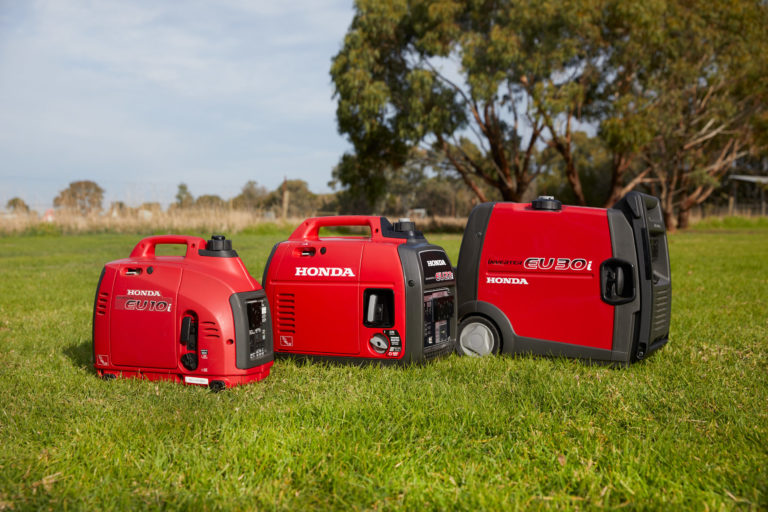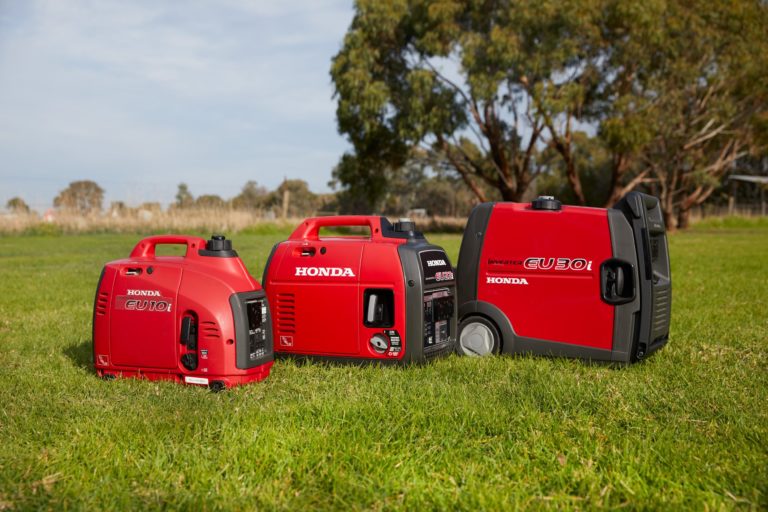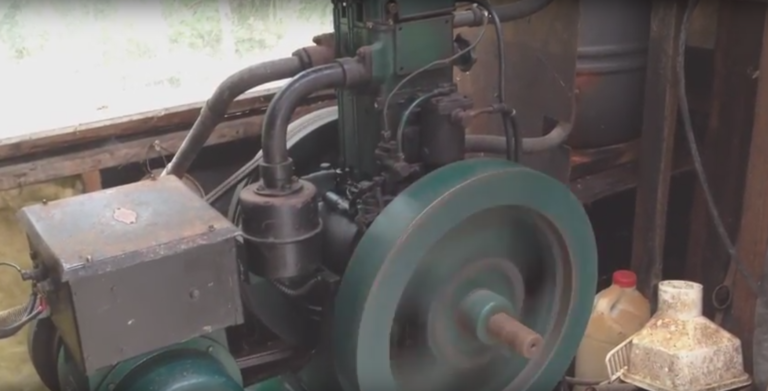Be prepared for outages and check out the latest generators
By Mark Beckett
Photographs: Mark Beckett
As winter approaches and power outages become something of a given, we thought it might be useful to identify what you need to know about generators, safety, their uses, and how to connect them to your home.
A generator is a motor driving an alternator to produce power, and with the advent of these Inverter Generators (see my review of Honda inverter generators) the basics haven’t changed, but how they operate has.
Safety
Like all motors burning fuel, generators give off carbon monoxide. This is a colourless, odourless killer that makes you fall asleep and doesn’t trigger any safety reflexes in the brain, so it will kill you.
While the fumes are deadly, the heat from the exhaust outlet can burn anything combustible if it’s too close. Unless you bolt it down, it can and will move around, so you need to be extra careful and check it regularly. Refuelling is the same with any hot motor, but if you’re struggling to pour fuel into a moving, vibrating hole, then think again and switch it off.
The standard mains supply ties the neutral to earth, so the voltage between phase and neutral/earth is 230v. A generator is floating so the phase and neutral voltage with earth can rise (just as if you are using an old-fashioned isolation transformer). Always ensure you connect the generator earth to the building earth if you’re powering part of the house.
As with any rotating machinery, keeping fingers out of harm is performed with safety covers or design. Ensure these are left in place and replace them if damaged.
Power basics
Mains power in New Zealand is approximately 230 volts AC and the frequency is 50Hz. The regulation specifies the voltage should be between 200 and 250v, but it should remain within 6 percent of what you and your power company decide. That’s not helpful, as I can’t recall having any discussion with my energy retailer, and mine measures 240v. Modern electronics use switch mode supplies, so they tend to handle voltage ranges from 100-250v without any effort, but many other appliances and especially light bulbs are less happy with high (or low) voltage.
The AC frequency is 50Hz and the regulation specifies it shall be within 1.5 percent. While it doesn’t worry most electronics, motors directly connected to the mains follow the frequency, so the speed will change. Thankfully the power companies do control frequency very tightly.
New Zealand houses tend to have a 63 Amp (or 40 A per phase on multi-phase installations). This equates to 15.12KW (or 9.6KW per phase) which is significantly more than the three generators in the review I performed for this article.
There are permanently mounted generators that provide power during a mains outage. Airports have them for lighting, hospitals for keeping services running, and some large office buildings to allow the lifts to go to the ground floor and discharge passengers.
Most of these are large diesel units fitted in the basement, but I’ve also seen a number of smaller-sized units fitted outside in a self-contained cabinet.
A generator rescued from the basement of a building being demolished after the Christchurch earthquakes
Sizing
For this article we chose some of Honda’s “portable” Inverter Generators (EU22i, EU30i, and EU70i). These are all petrol powered, with the 30 and 70 also having an electric start.
The rating was covered in the review, but basically the number relates to the max KW (or KVA), that is, EU22i is 2.2KW max. To check which size you need, you simply add up all the loads you wish to run at once.
All portable appliances have a plate showing the voltage and either power (W) or current (A) the appliance consumes when running. You multiply Volts x Amps to get the power: 230 x 1.5 A = 345 Watts. 1000 w = KW. Motors usually require two or three times their running current during starting, so unless it has some form of speed controller, include this into your sizing equation.
Uses
Many market stalls use a small “silent” generator to provide power while they run. You usually find these hidden out the back and unless you notice the power cord, sometimes you don’t even realise they are there.
Until the advent of higher powered battery tools, if you wanted to do something where there wasn’t power, you’d need a generator. Builders and other trades often use them when the site has no power, or the renovations make it safer to have the power disconnected.
Camping (or glamping) at non-powered sites is another popular use, but unless you’re on your own, it’s best to use a quiet model like the Honda EU22i.
There are baches and other “off-grid” locations that have solar (or wind) to charge batteries which connect to an inverter for light mains loads. They often have a generator to run larger domestic appliances and as backup to top up the batteries.
Large generators to provide back-up power
Another large generators to provide back-up power
Run the house
For extended power outages you can run PARTS of your house. I emphasize “parts” because even the EU70i can only provide 5.5KW which could power a modern oven, quick-boil jug, maybe the TV, and a few normal lights at the same time.
During a power outage you need lights for cooking, the toilet, and a central space. The TV might seem a luxury but it will update you on the weather and provides a welcome distraction. If you have gas hot water, then the unit will require power and this assumes you still have running water.
Heating can be an issue, but extra layers, blankets, hot water bottles, and thermals should provide some comfort.
If you live in the country then the septic tank will be fine for a week, and the chest freezer should stay cold for several days. The water pump may need to be connected to top up the header tank or provide water, but we’ve found the bath provides 50-100 litres so filling the bath provides water to top up the toilet cistern after flushing.
EU30is and EU22i compared to a 20L fuel container
Communications
It’s likely that the broadband connection will still provide signal, but the modem will need power. If your phone is still the old copper pair, then the cordless phone won’t work, so always keep a corded phone available (as the people of Christchurch discovered eight years ago). For us the phone line kept working but the local cellphone site stopped once the batteries went flat.
You’ll need to engage an electrician to provide a switch on or near the switchboard, and maybe swap a few circuits around inside the switchboard. He’ll also need to fit a socket somewhere to accept the power from the generator. This needs to be a suitable size to ensure the protection circuits will trip if there is a fault.
Obviously this is easier when the house is being built, but it’s still possible later, and having lived in the house you will probably have a better idea of your needs.
When we moved out into the country we were warned that the power sometimes fails, and with few customers on the road, there could be delays in restoration. I had planned to wire the switchboard for a generator connection which would also power the water pump (120m away), but somehow the cable from the switchboard to outside got overlooked, and hence it never got completed, so during the last extended power outage, the camping gear got dragged out for lights, and the gas cooker worked just fine for cooking and hot water, and we used the generator to watch TV via an extension cord out the window.
Placement is important
Most portable generator electrics are not IP rated, so you will need to consider the placement to avoid them getting wet, remembering the exhaust fumes and heat, and the ability to top it up with fuel. Campbell at OMC Power Equipment showed me the exhaust deflector and extended fuel tank they can supply. This helps with some of the preparations, but you need to ensure you have spare fuel on hand and cycle it to make sure it doesn’t go stale.
Testing
Having everything prepared and ready to go is great, but when it’s cold, dark, and wet (or snowing) can you manage to get it working? Can your partner or children manage? Are the instructions clear enough?
There is nothing like having a test to prove it works, but see if you can make it close to reality. I’d also suggest running it for three or four hours as you won’t wear it out. While doing this article I was shown a picture of the hour meter from a Honda EU20 that had run 6100 hours and was still working perfectly.
Exhaust outlets
Generator test
The biggest advantage of the Honda Inverter range is the ability to connect two or three units together to double or triple the power output. This means you can carry two EU22i’s to your site to provide power, as opposed to a helicopter trip with a larger unit.
The EU22i and EU30i also feature a separate 12v DC outlet. These provide 8.3 Amps (99.6 watts) and 12 Amps (144 watts) respectively to boost charge your solar or automotive battery.
The EU22i provides 1800w (2.2Kw max). This is the smallest, quietest, and lightest unit at 21kg, and while it won’t run your quick-boil jug (2.4kw) it will run a number of smaller appliances and power tools.
The EU30is provides 2.8KW (3.0KW max). Weighing 59kg it is heavier than the EU30ik but has a larger fuel tank and slightly higher power output than its wheeled brother.
The EU70i provides 5.5KW (7.0 KW max) and at 118kg is not exactly portable. It does have handles and wheels so you can move it around when you want to run it.
EU70is with 32Amp plug fitted to allow full power on a single cable
Eu30is front panel
Eco-Throttle is the name Honda give to the system that adjusts the engine speed to suit the load. With the Inverter technology the output voltage and frequency remain constant, regardless of the engine speed. This means the motor runs more quietly and uses less fuel when the load is light. If you try this with any older cheap generator you’ll find the output voltage goes outside the range and can cause damage to electronics if it goes too high.
I have an older 2.2KW generator and there is no comparison with the EU22i. This is quiet, light, doesn’t walk everywhere, and is economical. I dread using mine as the voltage is never constant, so I’m trying to work out how to make this new one “disappear”, rather than giving it back.
Voltage and…
…frequency of the EU22i
Which model you need depends on what you’re trying to do, and it pays to speak to your local dealer to find the model to suit your needs. They can also supply extra attachments to suit most needs.
Part of my test was to check the output voltage and frequency, and these were surprisingly stable. The voltage will dip a little when you suddenly load them running in Eco Throttle. This was to be expected as the generator has to detect the drop, open the throttle, and stabilise. If you have voltage sensitive equipment then turn off Eco Throttle, plug in the load, then switch it back on.
The frequency remained rock steady regardless of speed or load, which is certainly better than the old-style generators I’ve grown up with.
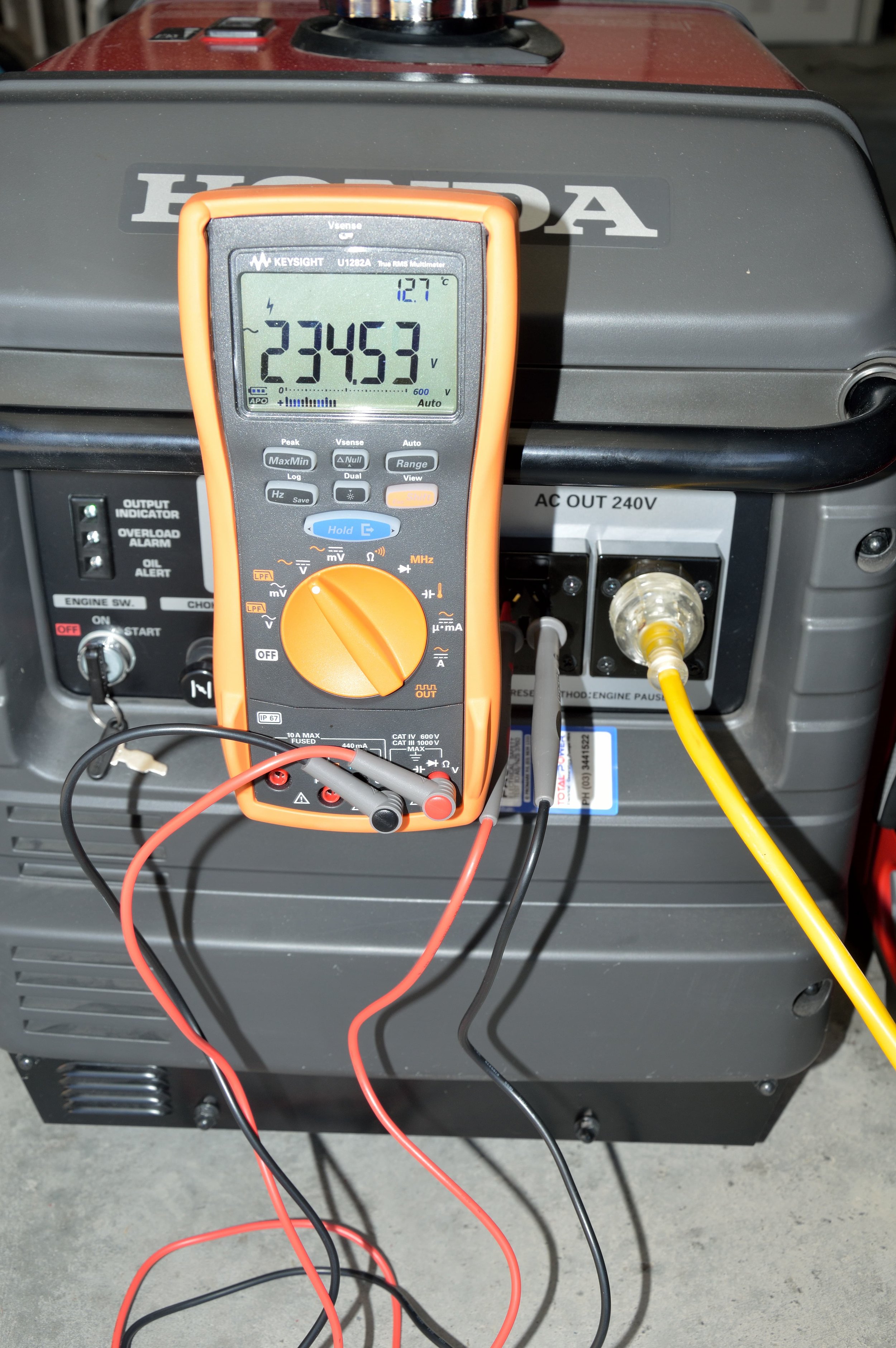
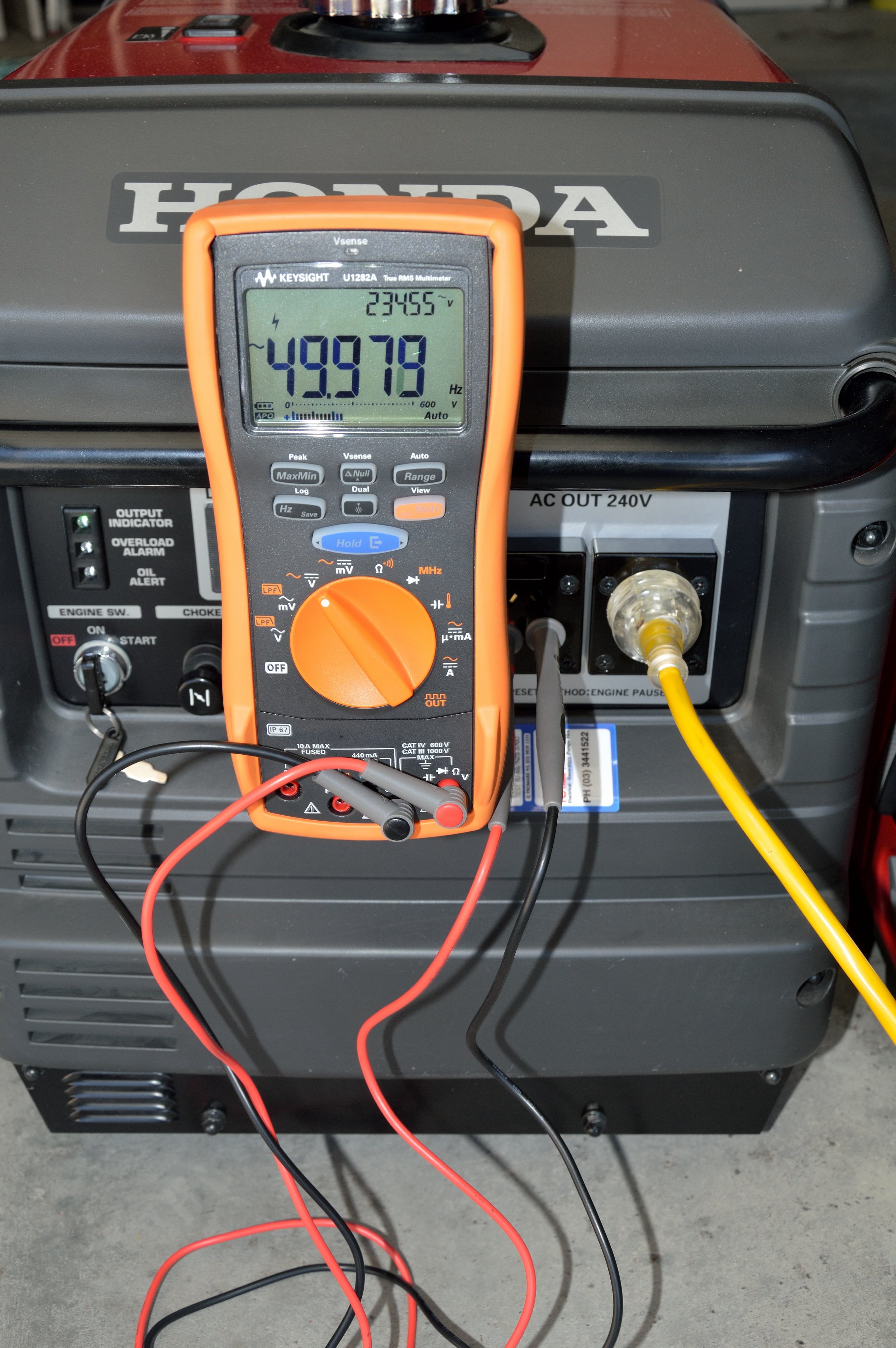
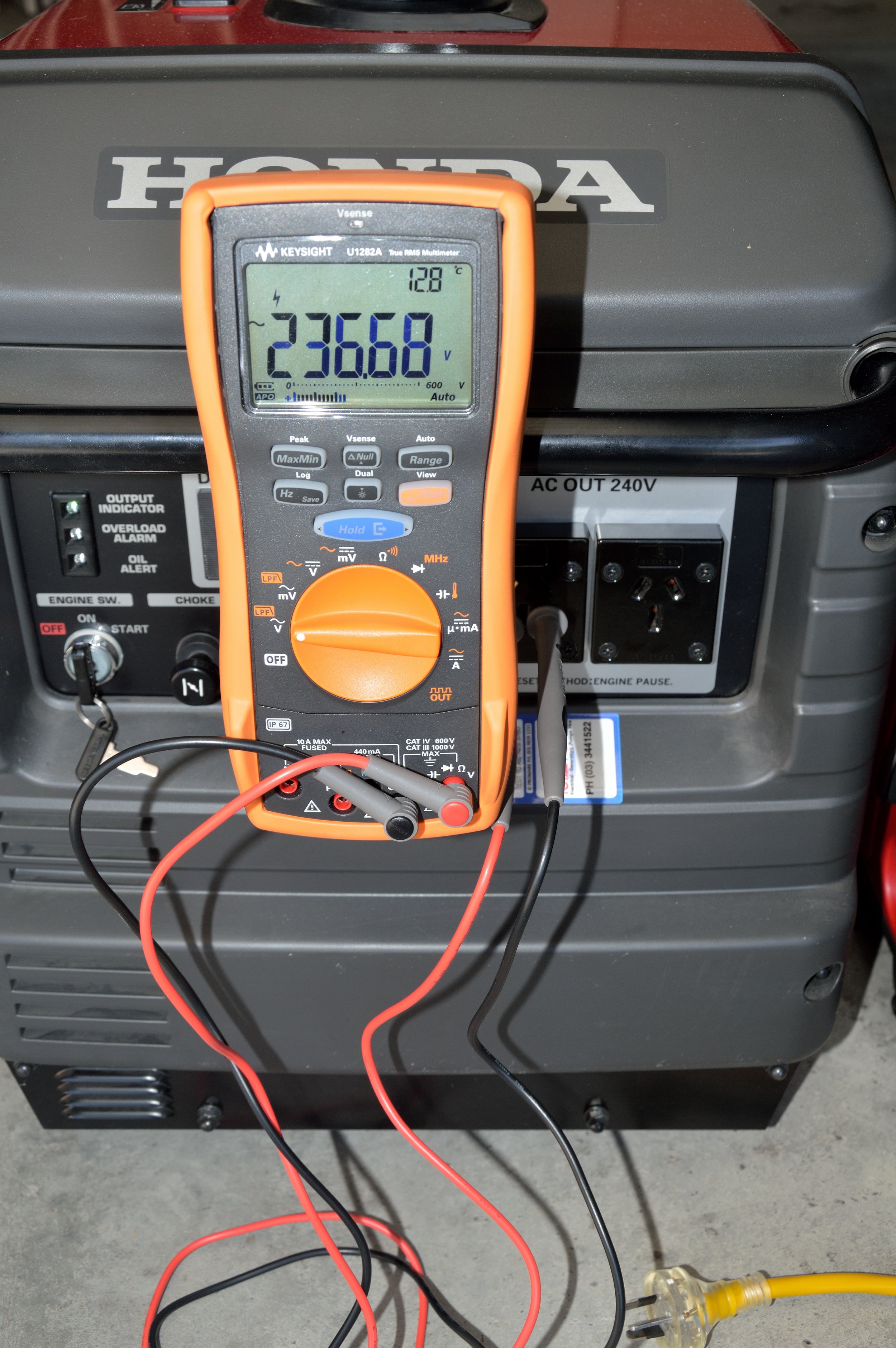
Images above: Voltage (left and right) and frequency (middle) for the EU30is showing difference between loaded and unloaded voltage readings
I’d like to thank Leon at https://www.hondapowerequipment.co.nz/, Tim at http://totalpowerhire.co.nz/ and Campbell at www.omcpowerequipment.co.nz for their help and advice in writing this article

